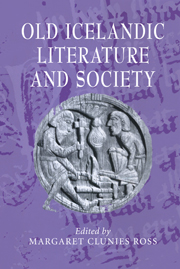Book contents
- Frontmatter
- Contents
- List of contributors
- Introduction
- 1 Social institutions and belief systems of medieval Iceland (c. 870–1400) and their relations to literary production
- 2 From orality to literacy in medieval Iceland
- 3 Poetry and its changing importance in medieval Icelandic culture
- 4 Óláfr Þórðarson hvítaskád and oral poetry in the west of Iceland c 1250: the evidence of references to poetry in The Third Grammatical Treatise
- 5 The conservation and reinterpretation of myth in medieval Icelandic writings
- 6 Medieval Icelandic artes poeticae
- 7 A useful past: historical writing in medieval Iceland
- 8 Sagas of Icelanders (Ílendinga sögur) and þœttir as the literary representation of a new social space
- 9 The contemporary sagas and their social context
- 10 The Matter of the North: fiction and uncertain identities in thirteenth-century Iceland
- 11 Romance in Iceland
- 12 The Bible and biblical interpretation in medieval Iceland
- 13 Sagas of saints
- Index
- CAMBRIDGE STUDIES IN MEDIEVAL LITERATURE
11 - Romance in Iceland
Published online by Cambridge University Press: 15 October 2009
- Frontmatter
- Contents
- List of contributors
- Introduction
- 1 Social institutions and belief systems of medieval Iceland (c. 870–1400) and their relations to literary production
- 2 From orality to literacy in medieval Iceland
- 3 Poetry and its changing importance in medieval Icelandic culture
- 4 Óláfr Þórðarson hvítaskád and oral poetry in the west of Iceland c 1250: the evidence of references to poetry in The Third Grammatical Treatise
- 5 The conservation and reinterpretation of myth in medieval Icelandic writings
- 6 Medieval Icelandic artes poeticae
- 7 A useful past: historical writing in medieval Iceland
- 8 Sagas of Icelanders (Ílendinga sögur) and þœttir as the literary representation of a new social space
- 9 The contemporary sagas and their social context
- 10 The Matter of the North: fiction and uncertain identities in thirteenth-century Iceland
- 11 Romance in Iceland
- 12 The Bible and biblical interpretation in medieval Iceland
- 13 Sagas of saints
- Index
- CAMBRIDGE STUDIES IN MEDIEVAL LITERATURE
Summary
In something of a parallel with its development in England, medieval romance in Iceland comes in two sequential categories – translations or adaptations from French or Anglo-Norman and independent narratives – known collectively to modern scholarship as riddarasögur (‘sagas of knights’) but often distinguished as ‘translated’ and ‘independent’ (or ‘Icelandic’) riddarasögur. The translated riddarasögur comprise Old Norse prose versions of French epic and romance, among them Marie's lais (in Strengleikar); Thomas's Tristan (Tristrams saga); and three Arthurian narratives by Chrétien de Troyes, Erec et Enide (Erex saga), Yuain (Ívens saga), and Perceval (Parcevals saga and Valvens páttr); produced in Norway, probably from Anglo-Norman exemplars (Leach 1921), for the court of King Hákon the Old (r. 1217–63). These sagas are, for the most part, preserved in Icelandic manuscripts and generally presumed to have reached Iceland soon after their composition. The independent riddarasögur, which are the focus of this discussion, appear in Iceland around the beginning of the fourteenth century. Frequently dismissed as the inferior, ‘escapist’, dreary, and depressing products of a gloomy period in Iceland's history following the surrender of its autonomy to Norway in 1262–64 and subsequent deterioration in its economic and political status, the riddarasögur have proved the least appealing form of Old Icelandic prose narrative to modern scholarship, which has tended to regard them as something of an embarrassment to the Old Norse literary corpus.
- Type
- Chapter
- Information
- Old Icelandic Literature and Society , pp. 266 - 286Publisher: Cambridge University PressPrint publication year: 2000
- 2
- Cited by



